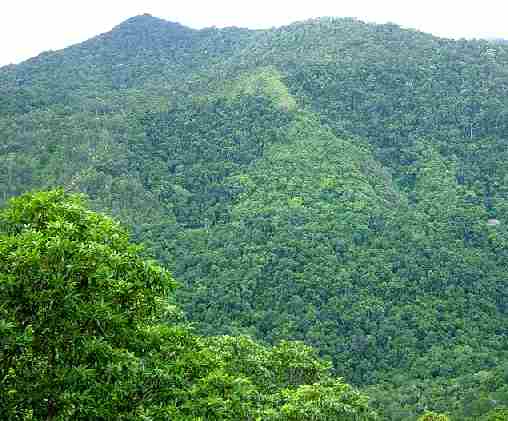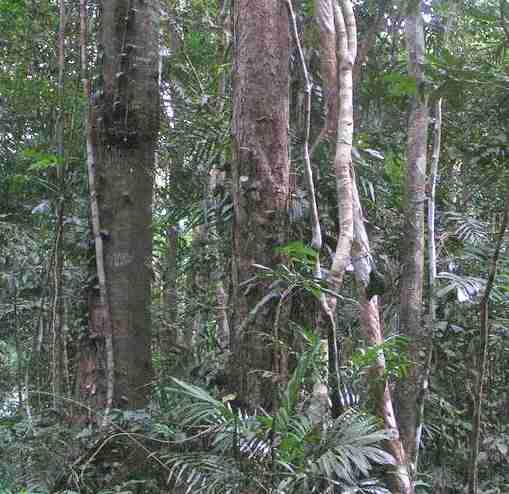|
RAIN FOREST
|
||
|
HOME | BIOLOGY | FILMS | GEOGRAPHY | HISTORY | INDEX | INVESTORS | MUSIC | NEWS | SOLAR BOATS | SPORT |
||
|
Rainforests, or rain forests, are forests characterized by high rainfall, with definitions setting minimum normal annual rainfall between 1750 mm and 2000 mm.
The largest tropical rainforests exist in the Amazon Basin (the Amazon Rainforest), in Nicaragua (Los Guatuzos, Bosawás and Indio-Maiz), the southern Yucatán Peninsula-El Peten-Belize contiguous area of Central America (including the Calakmul Biosphere Reserve), in much of equatorial Africa from Cameroon to the Democratic Republic of Congo, in much of southeastern Asia from Myanmar to Indonesia and Papua New Guinea, northern and eastern Australia and in some parts of the United States. Outside of the tropics, temperate rainforests can be found in British Columbia, southeastern Alaska, western Oregon and Washington, the northern coast of California, Scotland and Norway, the western Caucasus (Ajaria region of Georgia), parts of the western Balkans, Japan, southern Chile, New Zealand, Tasmania, and parts of northern and eastern Australia.
The Daintree Rainforest near Cairns Queensland, Australia
Rainforests are home to two-thirds of all the living animal and plant species on the planet. It has been estimated that many hundreds of millions of new species of plants, insects and microorganisms are still undiscovered. Tropical rain forests are called the "jewels of the earth", and the "world's largest pharmacy" because of the large amount of natural medicines discovered there. Tropical rain forests are also often called the "Earth's lungs", however there is no scientific basis for such a claim as tropical rainforests are known to be essentially oxygen neutral, with little or no net oxygen production.
Despite the growth of vegetation in a rainforest, the actual quality of the soil is often quite poor. Rapid bacterial decay prevents the accumulation of humus. The concentration of iron and aluminium oxides by the laterization process gives the oxisols a bright red color and sometimes produces minable deposits (e.g. bauxite). On younger substrates, especially of volcanic origin, tropical soils may be quite fertile.
The undergrowth in a rainforest is restricted in many areas by the lack of sunlight at ground level. This makes it possible for people and other animals to walk through the forest. If the leaf canopy is destroyed or thinned for any reason, the ground beneath is soon colonized by a dense tangled growth of vines, shrubs and small trees called jungle.
In contradiction to popular belief, rainforests are not major consumers of carbon dioxide and like all mature forests are approximately carbon neutral. Recent evidence suggests that the majority of rainforests are in fact net carbon emitters. However, rainforests do play a major role in the global carbon cycle as stable carbon pools. Clearance of rainforest leads to increased levels of atmospheric carbon dioxide. Rainforests may also play a role in cooling air that passes through them. As such, rainforests are of vital importance within the global climate system.
The Daintree Rainforest in Queensland, Australia
Rainforest layers
The rainforest is divided into five different parts, each with different plants and animals, adapted for life in that particular area.
Emergent layer
This layer contains a small number of very large trees which grow above the general canopy, reaching heights of 45-55 m, although on occasion a few species will grow to 60 m or 70 m tall. They need to be able to withstand the hot temperatures and dry winds. Eagles, butterflies, bats and certain monkeys inhabit this layer.
Canopy layer
The canopy layer contains the majority of the largest trees, typically 30-45 m tall. The densest areas of biodiversity are found in the forest canopy, a more or less continuous cover of foliage formed by adjacent treetops.
The canopy, by some estimates, is home to 40% of all plant species, suggesting that perhaps half of all life on Earth could be found there. The fauna is similar to that found in the emergent layer, but more diverse. A quarter of all insect species are believed to exist in the rainforest canopy.
Scientists have long suspected the richness of the canopy as a habitat, but have only recently developed practical methods of exploring it. As long ago as 1917, U.S. naturalist William Beebe declared that "another continent of life remains to be discovered, not upon the Earth, but one to two hundred feet above it, extending over thousands of square miles".
True exploration of this habitat only began in the 1980s, when scientists developed methods to reach the canopy, such as firing ropes into the trees using crossbows. Exploration of the canopy is still in its infancy, but other methods include the use of balloons and airships to float above the highest branches and the building of cranes and walkways planted on the forest floor. The science of accessing tropical forest canopy is called Dendronautics.
Understorey layer
There is a space between the canopy and the forest floor, which is known as the understorey . This is home to a number of birds, snakes, and lizards, as well as predators such as jaguars, boa constrictors, ocelots, and leopards. Armadillos also live here. The leaves are much larger at this level. Insect life is also abundant. Many seedlings that will grow to the canopy level are present in the understorey. Only about 5% of the sunlight shining on the rainforest reaches the understorey. This layer can also be called a shrub layer.
Shrub Layer
The layer just above the floor, consists of mainly large-leaved plants and small trees able to survive on the meager amount of light let through by the canopy.
Forest floor
This region receives only 2% of the rainforest's sunlight. Thus, only specially adapted plants can grow in this region. Away from river banks, swamps and clearings where dense undergrowth is found, the forest floor is relatively clear of vegetation, as little sunlight penetrates to ground level. It also contains decaying plant and animal matter, which disappears quickly due to the warm, humid conditions promoting rapid decay. Many forms of fungi grow here which help decay the animal and plant waste.
Fauna
Rainforests support a very broad array of fauna including mammals, reptiles, birds and invertebrates. Mammals may include primates, felids and other families. Reptiles include snakes, turtles, chameleons and other families. Birds include such families as vangidae and Cuculidae. Dozens of families of invertebrates are found in rainforests. More than half of the world's species of plants and animals are found in the rainforest. This amounts to over 5 million species of plants and animals.
Human uses
Many foods originally came from tropical forests, and are still mostly grown on plantations in regions that were formerly primary forest. Tropical rainforests are also the source of many medicinal drugs, with over half the medications originating from the rainforest. Tropical rainforests also provide timber as well as animal products such as meat and hides. Rainforests also have value as tourism destinations and for the ecosystem services provided.
Deforestation
Tropical and temperate rain forests have been subjected to heavy logging and agricultural clearance throughout the 20th century, and the area covered by rainforests around the world is rapidly shrinking. Biologists have estimated that large numbers of species are being driven to extinction (possibly more than 50,000 a year) due to the removal of habitat with destruction of the rainforests [1]. Protection and regeneration of the rainforests is a key goal of many environmental charities and organizations. (It is doubtful that this rate will be sustained as the relative cost of logging rises with dwindling resources.) About half the world's species of animals and plants depend upon these forests for their survival.
Another factor causing the loss of rainforest is expanding urban areas. Littoral Rainforest growing along coastal areas of eastern Australia is now rare due to ribbon development to accommodate the demand for seachange lifestyles.
LINKS and REFERENCE
Healthier alternative tastes for adventure capitalists
Solar Red | Solar Crush + | Solar Cola | Solar Citrus + | Solar +
|
||
|

